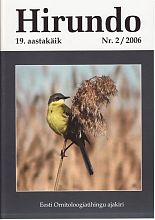Hirundo 2/2006
Erit, M.
The importance of the Silma Nature Reserve for birds breeding in meadows and reed-beds
Abstract: The aim of current study was to determine the role and level of importance of the Silma Nature Reserve (NR) for the birds, who prefer meadows and reed beds as their breeding habitat. To determine species and numbers of avifauna in Silma NR, breeding pairs in selected model areas were counted and this data was extrapolated on whole area of the NR. For less abundant species the effort was made to count all breeding pairs in the whole area. In total, abundance of 50 breeding species in was recorded. In the case of 17 species over 1% of total population in Estonia was represented in studied area. More than 5% of the total Estonian populations of bearded tits (Panurus biarmicus; 16,7%), greylag geese (Anser anser; 8,4%), mute swans (Cygnus olor; 6,5%), Savi’s warblers (Locustella luscinioides; 5,9%) and great reed warblers (Acrocephalus arundinaceus; 5,2%) breed in Silma NR.
Sein,G. & Lõhmus, A.
Nest-stand and nest-tree characteristics of the Golden eagle in Estonia
Abstract: Nest-site use by the Golden Eagle (Aquila chrysaetos) has not been studied in Estonia in detail before. This paper, based on nest-sites occupied in 1995–2004, (1) describes the eagle’s nest trees, their
surrounding forest stands and location on the landscape; (2) compares nest trees with average trees available around; and (3) explores the potential relationships between the location and nesting success of the eagle. The average tree composition of 21 nest stands comprised 49% Scots pine, 29% Norway spruce, 14% birch, 7% aspen, 1% black alder and 1% grey alder. Fifteen nests (71%) were built on pine, four on spruce and two on aspen. The average age of nest-trees was 142 (quartile range 130–155) years and the average diameter was 48 (41–51) cm. Amongst the available trees in the nest-stand, Golden Eagles selected nest-trees that were on average 35 years older and 19 cm thicker (16 cm in case of pines), which can be explained with the better nest-building opportunities in such trees. There was no such difference in tree heights. The closest forest edge was situated on average 56 m, road 1.8 km, and house 2.8 km from the nest; distances to the nearest occupied nest of another Golden Eagle and of the White-tailed Eagle (Haliaeetus albicilla) were 10 km and 2.8 km, respectively. No significant relationships were found between nest location on the landscape and breeding success there, but the analysis lacked power due to small samples and short time‐frame (breeding success could be only established as the average for two years in each nest).
Nellis, R.
Goshawk – bird of the year 2005
Drevs, T. & Jürgens, M.
Some observations on the nest-site preferences of the Merlin in Tallinn area
Notes (in Estonian)
Nellis, R. Nutcracker (Nucifraga caryocatactes) attacking a mouse
Elts, J. & Marja, R. A Tree Sparrow (Passer montanus) nestling in Jackdaw’s (Corvus monedula) diet
EOS chronicle and news (in Estonian)

